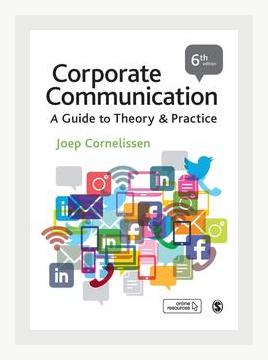Marketing and SalesPublic Relations
Introduction
Joep Cornelissen’s book, “Corporate Communication: A Guide to Theory and Practice,” provides a comprehensive framework for understanding and executing effective corporate communication within organizations. The book, published in 2011, is essential for professionals in public relations, marketing, and management as it unifies various theories and practices into actionable strategies.
Chapter 1: An Introduction to Corporate Communication
Cornelissen starts by delineating the scope of corporate communication, distinguishing it from related fields like marketing and internal communication. He establishes the importance of aligning corporate communication with organizational objectives and mission.
Actionable Advice: Conduct an audit of your existing communication practices to ensure they align with the organization’s mission and goals.
Example: A tech startup ensuring every blog post about new product features also emphasizes their mission of innovation and accessibility in technology.
Chapter 2: Corporate Communication in Contemporary Organizations
Cornelissen examines contemporary challenges in corporate communication, such as globalization, digitalization, and changing public expectations. The chapter underscores the need for agility and adaptability in communication strategies.
Actionable Advice: Stay updated with global trends and technological advancements that could affect your communication strategies.
Example: A multinational company incorporating multicultural elements in their ad campaigns to resonate with global audiences.
Chapter 3: Integrating Corporate Communication
This chapter focusses on the integration of messages across all channels and stakeholders, promoting consistency and coherence. Cornelissen introduces the concept of Integrated Communication Framework (ICF).
Actionable Advice: Develop an Integrated Communication Plan that ensures all departments are aligned in their messaging.
Example: A fashion brand ensuring that its sustainability messages are consistently communicated across advertising, customer service, and social media.
Chapter 4: Stakeholder Management and Communication
Cornelissen addresses stakeholder theory by segmenting stakeholders and tailoring specific strategies to engage them effectively. Understanding stakeholder influence and expectations is crucial.
Actionable Advice: Map out your stakeholders and develop bespoke communication strategies for each group.
Example: An energy company crafting specific messages on environmental impact for regulatory bodies, while highlighting reliability and cost-effectiveness to customers.
Chapter 5: The Corporate Brand and Reputation
The author discusses the creation and maintenance of a strong corporate brand and reputation. He emphasizes the interaction between corporate identity, corporate image, and corporate reputation.
Actionable Advice: Conduct regular brand audits and monitor online reviews to maintain a positive reputation.
Example: A restaurant chain actively responding to customer feedback on social media and review sites to show attentiveness and commitment to quality.
Chapter 6: Media Relations and PR
Media relations form a significant part of corporate communication. Cornelissen outlines best practices for media engagement, such as crafting effective press releases and organizing media events.
Actionable Advice: Develop a media kit and maintain a list of key media contacts to enhance media relations.
Example: A nonprofit organization preparing a media kit with fact sheets, case studies, and executive biographies to facilitate media coverage of their initiatives.
Chapter 7: Communicating in a Crisis
The author provides a detailed approach to crisis communication, advocating for preparedness and proactive management. Key steps include crisis planning, developing a crisis communication team, and establishing clear communication lines.
Actionable Advice: Develop a comprehensive crisis communication plan and conduct regular drills.
Example: An airline creating a crisis handbook that includes steps for handling scenarios like flight cancellations or technical failures, thus ensuring prompt and effective responses.
Chapter 8: Internal Communication
Cornelissen emphasizes the importance of internal communication in fostering a productive and motivated workforce. This involves transparent and continuous communication with employees.
Actionable Advice: Regularly update employees through newsletters, town hall meetings, and internal social media platforms.
Example: A retail company holding monthly town halls to discuss company performance, upcoming projects, and employee achievements.
Chapter 9: Corporate Social Responsibility (CSR) and Ethics
CSR is another critical component of corporate communication. Cornelissen explores the strategic integration of CSR activities into the overall communication strategy to enhance corporate legitimacy and stakeholder trust.
Actionable Advice: Publicly report on CSR activities and achievements to demonstrate commitment to social and environmental responsibilities.
Example: A food company publishing an annual sustainability report outlining its initiatives to reduce carbon footprint and support local farmers.
Chapter 10: Information Technology and Corporate Communication
The book also emphasizes how the rise of digital communication channels has transformed corporate communication. Effective use of IT can amplify messages, facilitate real-time communication, and improve engagement.
Actionable Advice: Leverage digital tools such as social media management platforms, email marketing tools, and analytics to enhance communication strategies.
Example: A financial services firm using a social media management tool to schedule posts, monitor engagement, and analyze performance metrics.
Chapter 11: Change Management Communication
Effective communication is pivotal during times of organizational change. Cornelissen outlines strategies to manage communication during mergers, acquisitions, and restructurings.
Actionable Advice: Prepare a detailed communication plan for changes that includes clear timelines and key messages for all stakeholders.
Example: A manufacturing company rolling out a communication plan when introducing a new production process to ensure all employees understand the changes and their roles.
Chapter 12: Measurement and Evaluation
The final chapter emphasizes the importance of measuring and evaluating communication efforts. Cornelissen advocates for using metrics and KPIs to assess the impact and effectiveness of communication strategies.
Actionable Advice: Establish KPIs for all communication campaigns and regularly review performance against these metrics.
Example: An ecommerce site tracking campaign performance with KPIs like engagement rates, click-through rates, and conversion rates to refine their communication approaches.
Conclusion
Joep Cornelissen’s “Corporate Communication: A Guide to Theory and Practice” serves as a valuable resource for professionals seeking to understand the complexities and nuances of corporate communication. By providing a thorough theoretical framework matched with practical advice, the book equips readers with the tools necessary to navigate and excel in the dynamic field of corporate communication.
